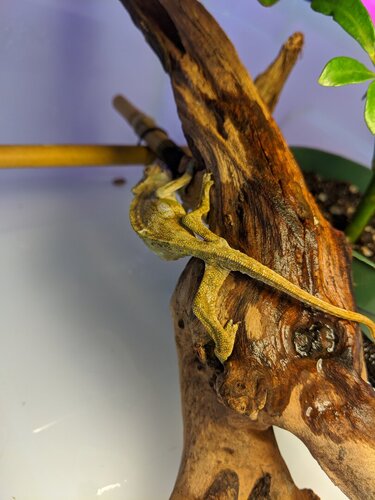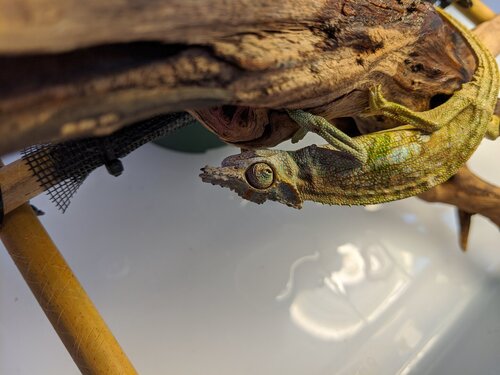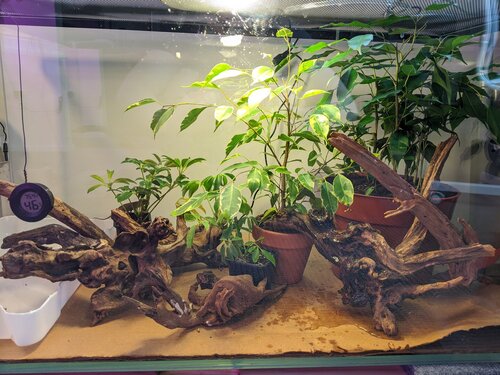Chameleon Info:
Cage Info:
Current Problem
Images:
Shot of just how underweight he is:

Mouth growth:

Enclosure:
Ignore the cardboard, I was trying it out to see if it would help prevent the dripper water from accumulating on the bottom(I was worried about potential bacteria) so I wouldn't need to disrupt the enclosure regularly to clean it up. It's been in since Saturday and will be removed today. (Could this be related to the issue? It loosely correlates with the timing of the issue, but it's clean cardboard, I'm not sure why it would cause any issues)
The white plastic tray on the left is the feeding area. I am currently keeping dubias constantly stocked in the enclosure to attempt to get some additional weight on the chams.

- Your Chameleon - Kinyongia boehmei, male, adolescent(guessing, wasn't able to get an age from the seller). I've had him about 2.5 weeks.
- Handling - Once every 1-2 days(multiple times a day currently to try to get him eating more)
- Feeding- 1/4 -1/2 inch Dubias, gut loaded with Repashy SuperLoad Insect Gutload, dusted with Repashy Calcium Plus
- Feeders: 1/4 - 1/2 inch(estimate) Dubias
- Gutload: Repashy SuperLoad Insect Gutload
- Powder: Repashy Calcium Plus
- Schedule:
- I gut load about 10-20 dubias every night before bed
- Each morning I remove any surviving dubias from the previous day and return them to the Dubai colony. I then place the new gutloaded dubias into the feeding area.
- Feeders: 1/4 - 1/2 inch(estimate) Dubias
- Supplements - Repashy Calcium Plus
- Watering
- Mist every morning and again in the afternoon/evening
- I use a diy drip system that is just gravity fed through some airline tubing
- No set schedule for drip system. I drip at least 10oz in a day in addition to misting
- Fecal Description
- Has not had a fecal test. I am looking into local exotic vet availability because I would like to get him a fecal test, but it's tough currently.
- I believe feces look normal, dark center and white liquid around the solids. There was one instance of him passing green tinted feces, but it only happened once about a week ago.
- History - I bought the male and two females from an online distributor, two of the three(1m and 1f) were very underweight upon arrival, the other female looked like she could hain a little weight, but was nowhere near as bad as the other two.
Cage Info:
- Cage Type- 36 x 18 x 18
- all glass w/ screen top
- currently horizontal, just waiting on a hardware shipment(any day now) to be able to install front baffles, sliding doors, and turn it upright
- screen top
- Lighting
- 2x Exo Terra Repti-Glo 5.0
- What brand, model, and types of lighting are you using? What is your daily lighting schedule?
- Temperature
- I have not found that there is a significant difference in temp from bottom to top. There are higher temps directly under the bulbs
- evening temp ranges from 68-72F(ambient room temp)
- day temp ranges from 74-80F
- Made sure to provide places(branches) for the chams to bask closer to the bulbs
- Humidity
- Humidity ranges 40-60, usually on the lower end except for right after misting
- humidity controlled by misting
- I am using a household humidity sensor(inside enclosure) I got off amazon, I have confirmed it's readings with a secondary humidity sensor
- What are your humidity levels? How are you creating and maintaining these levels? What do you use to measure humidity?
- Plants - Ficus Benjamina and Schefflera arboricola
- Placement
- Currently sitting about 6 inches off the floor(temporary until I can turn it vertical) making the top about 24 inches off the floor
- In low traffic area, except when feeding dogs(dogs are fed in that room, but otherwise there is little to no traffic)
- enclosure has a blocked off with a standing barrier to prevent when I am not doing maintenance or handling the chams to prevent them from seeing the other animals
- Location - Seattle
- Additional
- To prevent stagnated air in the bottom of the enclosure I am using a couple small computer fans
- The enclosure contains three adolescent chams currently(1m 2f). The seller assured me that they were good in groups, and I did find evidence that they have been kept like this, but I couldn't find a ton of information on the species. I am prepared to separate them if they show any signs of aggression or stress as they grow larger.
- The two females are doing well, the smaller one was in about the same condition as the male when she arrived but has been slowly putting on weight.
Current Problem
- Growth on mouth
- When I first got him a couple weeks ago he had a very small bump on the right side of his mouth. It has gotten larger since then and I am starting to worry about it.
- Underweight
- He was very underweight when he arrived
- he has not gained or lost any weight since then
- He has been readily accepting dubia roaches
- His desire to eat has rapidly dropped over the past two days
- He ate 1 dubia yesterday morning(hand fed) and 3 dubias(on his own) late yesterday but has not eaten yet today despite attempting to hand feed him(he usually will accept one or two by hand if he hasn't already eaten recently)
- He has also been drinking less which really has me worried
- I sat with him for around 20min during lunch today dripping water on a ficus' leaves while he sat on my hand(wouldn't move to the tree)
- He eventually took two licks of the water off a leaf then went to sleep
- He was very underweight when he arrived
- Lethargic
- This started yesterday. I had hope towards the end of the day because he started moving around the enclosure and even went and ate a few dubias, but today he's noticeably worse
Images:
Shot of just how underweight he is:

Mouth growth:

Enclosure:
Ignore the cardboard, I was trying it out to see if it would help prevent the dripper water from accumulating on the bottom(I was worried about potential bacteria) so I wouldn't need to disrupt the enclosure regularly to clean it up. It's been in since Saturday and will be removed today. (Could this be related to the issue? It loosely correlates with the timing of the issue, but it's clean cardboard, I'm not sure why it would cause any issues)
The white plastic tray on the left is the feeding area. I am currently keeping dubias constantly stocked in the enclosure to attempt to get some additional weight on the chams.




